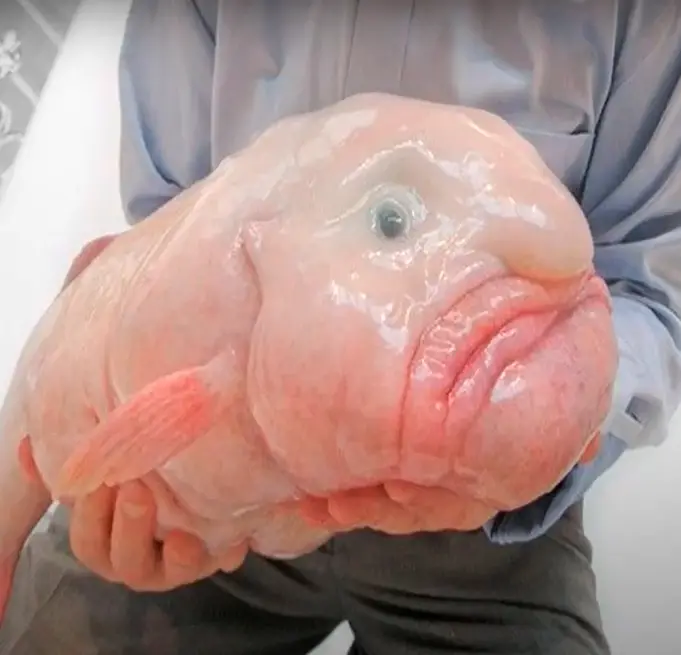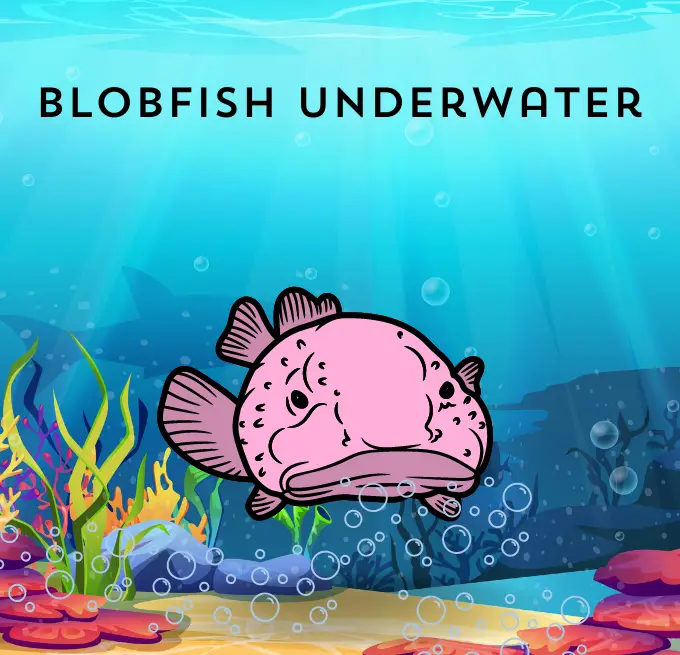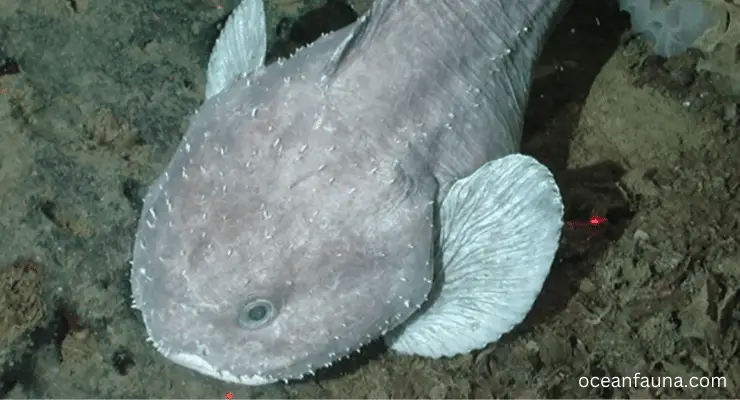If you’re wondering whether blobfish are real, the answer is yes. Blobfish are deep-sea fish that live underwater and have been dubbed the ugliest animal in the world. Marine life learners are always curious about this weird looking sea creature.
So, this article is for you. Here you will learn about all the unbelievable but real facts about blob fish in water.

20 Unbelievable but Real Facts About Blobfish Underwater
Here are 20 amazing facts about blobfish in water. So read on.
Fact 1. Family “Psychrolutidae“
Blobfish are also known as blobfish, blob sculpin, fathead sculpin, and so on. There are four species of fish that belong to the family Psychrolutidae and are commonly referred to as Blobfish. The scientific name of these species are Psychrolutes marcidus, Psychrolutes phrictus, Psychrolutes microporos, and Psychrolutes occidentalis.
Fact 2: Ugliest animal
The Ugly Animal Preservation Society held a competition in 2013 to draw attention to endangered species. Participants were encouraged to cast their ballots for the most repulsive animal they could imagine, with the winner serving as the group’s official mascot. The blobfish won with 795 votes out of a total of more than 3000 casts.
Although blobfish look strange, their unique appearance is due to the environment and water pressure of the deep ocean where they live.
Fact 3: Looks normal in the deep ocean
Blobfish live in the deep ocean, where the pressure is intense. In this environment, blobfish have a slimy, gelatinous texture that allows them to float above the ocean floor without expending energy on swimming. In this environment, they look like other bony fish.
But when blobfish are brought to the surface, their bodies can’t handle the sudden change in pressure. They become blob-like, and their features appear exaggerated.
Fact 4: Only discovered in the 20th century
Blobfish was not discovered until the late 20th century. The first blobfish was caught off the coast of Australia in 2003, and since then, more blobfish have been found in deep-sea habitats around New Zealand, Japan, and Norway. Despite their recent discovery, blobfish has likely existed for millions of years in the deep ocean.
Fact 5: Become famous because of Mr. Blobby
Mr. Blobby was the name the ship’s crew gave to the first blobfish, which was discovered in 2003 off the coast of New Zealand. Previously, Mr. Blobby’s body was preserved in formaldehyde by being kept in a jar, but now that practice has been abandoned. Later, it was kept in ethyl alcohol at a 70% concentration.

The Australian Museum houses Mr. Blobby in their Ichthyology Collection. The Australian Museum reports that Mr. Blobby’s fixation process has gradually altered his look over time, including a reduced nose size and a tightening of his skin.
Fact 6: Instead of muscle, have gelatinous mass
People sometimes ask, “Do blobfish have muscles or bones?” The answer is no; blobfish has no muscles or bones. Instead, the blobfish’s body is made up of a jelly-like substance that allows it to survive the intense pressure at great depths. This soft tissue makes them appear blob-like and featureless when brought to the surface.
Fact 7: Live at great depths
Where do blobfish live? Well, blobfish are found at depths between 2,000 and 4,000 feet (600 and 1,200 meters) in the ocean of Australia, Tasmania, and New Zealand. These underwater creatures inhabit areas where the pressure is several dozens of times higher than at sea level.
Fact 8: Have no sharp teeth
Blobfish do not have teeth like other fish. Instead, they have short, small, non-sharp conical teeth. These teeth are just to hold their prey.
Moreover, they have blob-like protrusions on their tongue called “lamellar lips.” These lamellar lips are used to suck up edible materials from the ocean floor. And they swallow their food whole without any bites.
Fact 9: Have a long lifespan
People often ask, “How long do blobfish live?” This answer depends on the species and their habitat. But blobfish can live up to 130 years.
Due to their slow movements and sedentary lifestyle, blobfish are very energy-efficient creatures, allowing them to have a longer lifespan compared to other fish species.
Fact 10: Don’t have any swim bladder
Blobfish don’t have swim bladders like other fish to control their buoyancy, which means they just hover around the ocean floor. Blobfish don’t have a swim bladder because it would actually rupture at the depths these fish live. This is due to the immense pressure that exists in those areas. The only thing that provides some buoyancy for blobfish is their gelatinous skin.
Fact 11: Slow swimmers and eaters
Blobfish are not very active creatures. They float slowly along the ocean floor and eat whatever edible material they come across, including crabs and shellfish. They do not need to search for food as it is plentiful in their deep-sea habitat.
Fact 12: Endangered species
Unfortunately, blobfish are classified as an endangered species due to deep-sea trawling. This fishing practice involves dragging large nets along the ocean floor and often destroys blobfish habitats and accidental capture of blobfish in the nets.
Fact 13: Lay up to one lacs of eggs at once
According to marine biologists, an adult female blobfish can lay up to 1,00,000 eggs at once in a single nest on the sea floor. However, some of the species lay between 10,000-50,000 eggs. The blobfish’s eggs are tiny and pinkish-coloured, with a diameter of only 1-2mm.
Fact 14: Have no scales
Blobfish do not have scales like other fish. When viewed from the side, a blobfish appears to have loose, pink skin that is covered in spines rather than scales. The blobfish is characterized by its large size, which includes its massive head, mouth, eyes, and snout.
Their blob-like bodies are covered with slimy skin, which helps them to survive the intense water pressure at great depths in the ocean. This feature also allows blobfish to move slowly along the sea floor without expending too much energy.
Fact 15: They are nicknamed “fathead”
Blobfish have also been nicknamed “Fathead” due to their blob-like appearance and large heads. These blob-shaped fish are not the most attractive creatures in the ocean, but they do play an important role in their deep-sea ecosystem as scavengers and predators.
Fact 16: Blobfish are edible
Can you eat blobfish? The answer is yes. You can eat Blobfish. However, blobfish are not considered a desirable or tasty food source for humans. This is mainly due to their gelatinous bodies and slow movements, which do not provide much meat for consumption. Some blobfish also contain high levels of toxins in their flesh, making them potentially dangerous to eat.
Fact 17: Have a poor vision
Blobfish are not known for their sharp eyesight. These deep-sea dwellers rely more on their sensory organs, such as taste and smell, to find food and navigate the ocean floor. Their blob-like bodies also make it difficult for them to swim and chase after prey, so they primarily eat slow-moving or stationary food sources.
Fact 18: Have a blob-like appearance due to the water pressure
Why do blobfish look different underwater? The reason is high water pressure underwater. The blobfish’s unique, blob-like appearance is not its natural form. The intense water pressure at the depths where blobfish live causes their bodies to collapse and appear flattened or blob-like. A blobfish will regain its normal shape and appearance when brought to the surface.
Fact 19: Not much is known about blobfish
Due to their deep-sea habitat and slow movements, blobfish are not well studied by scientists. There is still a lot that is unknown about blobfish behaviour, reproduction, and overall population numbers.
However, the endangered status of blobfish has prompted more research on these unique deep-sea creatures in recent years.
Fact 20: No documentary on alive blobfish underwater has ever been made
Although it is easy to find videos of almost any fish online, alive blobfish is an exception. This is because humans have not been able to collect enough data in the deep ocean due to the severe conditions there. Extremely few photographs have ever been taken underwater, and most of what we know about them comes from dead blobfish found in trawling nets.

FAQs
Do blobfish have brains?
Yes, blobfish do have a brain. In fact, they have relatively large brains compared to their body size. You may wonder how this ugly creature has a brain. Well, you should know that they are very intelligent predators. They are also quick learners and have been known to adapt to changes in their surroundings.
Do blobfish have gills?
Yes, blobfish do have gills. However, their gills are very different from those of other fish. Blobfish have long, thin gills that allow them to extract oxygen from the water around them. These gills are very efficient at extracting oxygen, which allows blobfish to thrive in the deep sea where other fish would quickly suffocate. So, while blobfish may not look like other fish, they have some similarities, including gills.
Are blobfish dangerous to humans?
Blobfish are not considered dangerous to humans. They are slow-moving, non-aggressive creatures that do not typically interact with humans. But they are not edible. That is because blobfish has been found to contain high levels of toxins in their flesh, making them potentially harmful to consume as food. So, its consumption can be dangerous for you. So, it is best to avoid contact or consumption of blobfish for safety reasons.
Do blobfish die when they reach the surface?
Yes, blobfish die when they reach the surface due to the drastic change in air pressure. Blobfish are found at depths of up to 1200 meters where the pressure is approximately 120 times greater than at the surface. They have a gelatinous body that is adapted to the high-pressure environment in which they live.
When brought to the surface, their bodies are no longer able to withstand the change in atmospheric pressure, and they experience rapid and fatal decompression.
Due to their inability to survive at surface levels, blobfish are incredibly elusive and difficult to photograph in their natural habitat. The best-known blobfish specimen was found by the research vessel NORFANZ in 2003 and is now preserved at the Australian Museum. This specimen is the only known photograph of a live blobfish in its natural habitat.
Why do blobfish turn pink?
Blobfish turn pink when they are brought to the surface because of the rapid depressurization that occurs during the process. The drastic change in pressure causes the fish’s tissues to expand and become damaged, leading to its unusual appearance.
However, this pink, melancholic blobfish that is often portrayed in pictures is not what it looks like in its natural habitat. Found at depths of up to 4,000 feet in the waters off the coast of Australia, the blobfish appears like a normal fish with a less compressed shape and dark, brownish-grey color.
Conclusion
So are blobfish real or not? Hopefully, you are clear. While blobfish may not be the most attractive or well-known ocean creatures, they are definitely real and play a crucial role in their deep-sea ecosystem. With more research and understanding of blobfish behaviour, we can work towards protecting these unique and endangered animals.


Perfect for projects and more.
Thank you